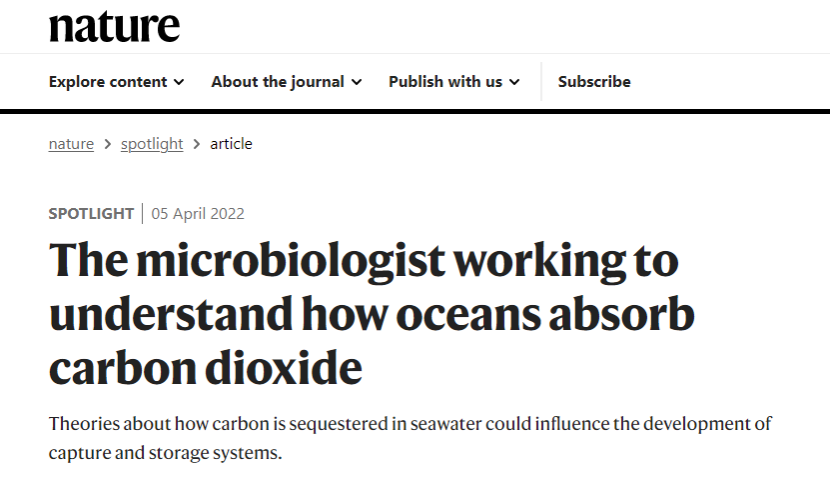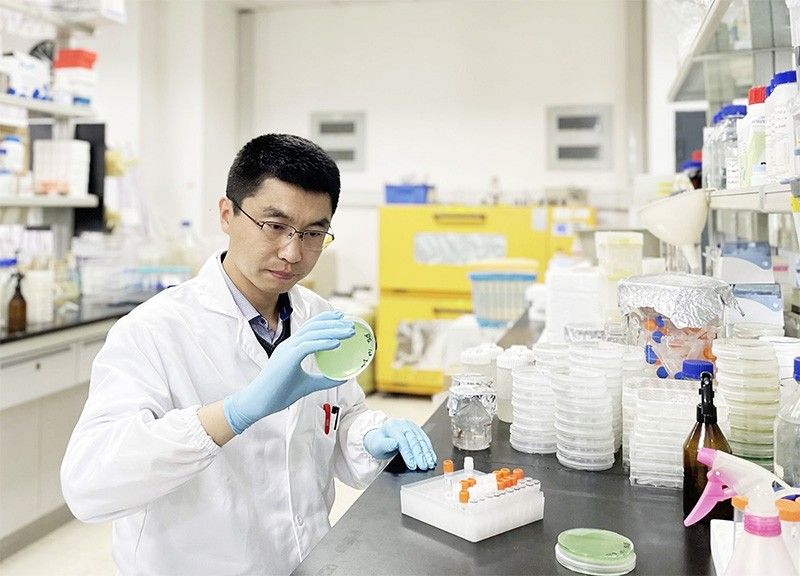
2022年4月5日,英国《自然》(Nature)杂志聚焦中国零碳排放之路,在增刊发表文章 “The microbiologist working to understand how oceans absorb carbon dioxide”,报道了4166金沙之选主页通道、海洋与地球学院科研团队在海洋碳汇、增汇过程和机制方面的研究工作。在该文中,《自然》杂志编辑Sarah O’Meara 与Yvaine Ye就海洋微型生物碳泵(MCP)的储碳机制、其在全球变暖背景下的潜在应用价值以及当前所面临的挑战等问题,对郑强副教授进行了采访。

郑强副教授在实验室进行海洋微型生物研究
(照片拍摄者: 王晓蒙)
郑强副教授主要研究海洋微型生物介导的碳循环过程和机制,以下为采访报道的参考译文:
致力于研究海洋储碳的微生物学家
海洋微型生物能够将环境中的溶解有机碳代谢为可在海水中存留数千年的惰性溶解有机碳 (RDOC)。郑强及其所在团队正试图揭示这些微型生物是否可以通过一种环境友好的方式将更多的CO2储存到海洋中,从而减弱全球变暖带来的气候效应。他向《自然》讲述了其所在团队的相关工作以及中国政府和科研资助机构为鼓励研究气候变化解决方案所作的努力。
微型生物碳泵的由来?
海洋中蕴含着一个巨大的碳库,其碳储量是陆地碳库的20倍,其中包含的溶解有机碳库与大气CO2的碳量相当。2010年,我的导师焦念志教授在国际上首次提出了微型生物碳泵(MCP)的概念,用以解释海洋巨大溶解有机碳库的起源。在此之前,我们团队及一些同行专家发现海洋细菌仅能消耗某些活性相对较高的有机碳,并释放或累积一些难以利用的有机碳。放射性碳年代测定结果表明,这些累积的有机碳已存在于海洋中约5000 年,由此,我们推测这些有机碳对细菌而言是无法被利用的(具有生物惰性),这使其可以长期存在于海洋中。
下一步研究重点是?
目前团队正在进行原位环境的实验,以此不断完善理论。例如,室内实验数据表明,海水中存在的大量营养盐不利于微生物产生积累RDOC。陆源输入的氮、磷营养盐在河口、近岸会加强细菌的呼吸作用,从而增加CO2的释放量,减少RDOC在环境中的储存和累积。
我们希望通过陆海统筹、减少陆地与河流中营养盐的输入来实现海洋增汇,如减少陆地农田的施肥量,或在河岸种植树木来减少水体中的营养盐,由此可以分析近岸海水中会增加多少有机碳储存量。下一步的研究重点是厘清相关过程机制,揭示微生物与环境的相互作用机理,以便开展现场实验。
目前面临哪些挑战?
海洋微型生物将活性溶解有机碳转化为RDOC的分子过程和机制仍是一个黑箱。多学科的交叉合作将有助于进一步认识RDOC的分子组成和化学结构,并深入挖掘其潜在的形成机制和碳汇效应。化学家可以提供有机碳相关的专业知识和分析仪器,而物理海洋学家可以协助厘清有机碳在海洋中的传输过程,探究近岸海洋环境的变化对深海中储存的有机碳所产生的影响。为了将理论研究更好地应用于实践,该项研究需要地方政府的政策支持,尤其是环境和海洋相关部门的政策支持,以便在自然水体中进行更大尺度规模的实验。
您是否看到碳封存研究的经费有所增加?
近些年来,海洋碳储存领域备受关注,经费来源也越来越多。我们也看到了来自中国政府、地方、大学和其他研究机构的更多支持。2015 年以来,许多养殖业和重工业企业希望我们帮助他们衡量其项目工程可以捕获多少碳,以便他们能够参与中国的碳交易——这是一项激励公司减少碳排放的计划。例如,福建省连江县政府咨询我们在河流中降低营养盐对于近岸碳储存的贡献,中国海洋石油总公司也在积极寻求如何在海洋中封存更多的碳。目前,我们还是更多地专注于理论研究,然后才能更准确地量化企业相关项目的碳封存量。
请介绍一下4166金沙之选主页通道的碳中和创新研究中心
该中心成立于2020年12月,主要包括含碳化合物的化学表征和惰性机理、海洋碳汇的生物学和生态学机制等十个研究方向。该中心是一个跨学科的合作机构,研究人员共享科研设备,定期开展学术交流,以期在短时间内取得突破。目前,它的主要经费来源是大学及国家自然科学基金。
The microbiologist working to understand how oceans absorb carbon dioxide
Qiang Zheng, a microbiologist at Xiamen University in southeast China, wants to know whether bacteria and other marine microorganisms can be harnessed to help combat global warming. These organisms metabolize organic matter dissolved in seawater into a form of carbon that can persist in the ocean for millennia, known as recalcitrant dissolved organic carbon (RDOC). Zheng is trying to work out whether these microbes could provide an environmentally friendly way to stash away atmospheric carbon that is pumped into the ocean, thereby helping to lessen global warming and mitigate climate change. He tells Nature about his work, as well as efforts by China’s funders and government to encourage research into solutions for climate change.
Where did the idea of a microbial carbon pump come from?
Scientists have long known that there is a large amount of carbon stored in the ocean, as much as 50 times more than in the atmosphere (see go.nature.com/3tzuogk). In 2010, my PhD supervisor Nianzhi Jiao, who also leads our research group, and others suggested the idea of a microbial carbon pump to explain the origins of this huge reservoir of organic carbon.
Our team has since found that marine bacteria consume only certain types of organic matter, including carbon, and leave out other types. Radiocarbon dating has shown that some carbon compounds have existed in the ocean for 5,000 years. We suspect that these compounds are refractory, or biologically worthless, to bacteria.
We are currently working on some field tests as we improve our theories.
For example, our laboratory experiments found that microorganisms tend to generate less RDOC in water that has large quantities of chemicals and minerals, such as those from chemical fertilizer or sewage. Specifically, fertilizer runoff in streams and rivers encourages bacterial respiration, which increases the amount of carbon dioxide released from the water, and reduces the amount stored as RDOC.
We want to test this outside the lab and measure how much carbon would be stored in coastal seawater if we limited the amount of fertilizers used by nearby farms, or reduced runoff by planting trees along the river bank, for example.
Working out exactly how these processes influence each other is the next focus of our research, and understanding their interactions will help us to design the field tests.
What challenges do you face?
At this stage, the process through which marine microorganisms turn dissolved organic carbon into RDOC is still a black box.
Multidisciplinary collaboration will help us to identify RDOC compounds and their molecular formulas and chemical structures and dig into the underlying mechanisms. Colleagues in chemistry departments can contribute relevant expertise and instruments, and those in physics and geography labs can help us to work out how the compounds move through the sea on a larger scale, looking at how changes in the chemical make-up of coastal water could affect carbon stored in deep sea water, for example.
And to turn theoretical research into real-world applications, we need policy support from local authorities, especially from the environment- and marine-related departments that can grant permission for experiments in nature, especially on a large scale.
Have you seen an increase in funding for carbon-sequestration research?
The field of ocean carbon storage has received a lot of attention, and funding opportunities have been increasing. We’ve also seen more support and cooperation from local governments in China, and from other research groups and universities.
Since 2015, many manufacturing and heavy-industry companies have asked us to help them measure how much of the carbon generated by their projects they can trap so they can participate in China’s carbon-trading market — a scheme to incentivize companies to reduce their carbon emissions. The number of requests really increased in 2020, the year before China was due to officially launch the scheme.
For example, the Lianjiang county government asked us about quantifying how much carbon it could sequester by planting trees along river banks. The China National Offshore Oil Corporation in Beijing, which emits 40 million tonnes of CO2 each year, enquired about finding ways to sequester more of its carbon emissions in the ocean.
Our lab hasn’t reached an agreement with any of them yet. We need to focus on theoretical research before we can offer to quantify companies’ sequestration.
Tell us about Xiamen University’s Carbon Neutral Innovation Research Centre.
The centre was established in December 2020. It focuses on ten research directions, including the chemical characterization and inert mechanisms of carbon compounds, and the biological and ecological mechanisms of marine carbon sinks.
The centre wants to have breakthroughs in a short period of time and is an interdisciplinary collaboration. Researchers share equipment, hold regular academic presentations and exchange ideas. Currently, its main source of funding is the university, along with some national grants. It is one of 20 similar centres set up at Chinese universities in the past 2 years or so.
Why is it necessary to establish these centres?
It’s too early to say whether it is necessary. The real effects of the centres will take time to be verified. As far as I know, many of them have received support only from their institutions and local authorities. Only a few have received national funds or policy support.
Carbon-neutrality research requires a wide breadth of expertise. These centres need to be set up at the universities and institutes that have the best experience and expertise to lead the field. If they are built in a hurry as a mere response to government policy targets, they might not deliver tangible, long-term results.
原文链接:
https://www.nature.com/articles/d41586-022-00804-1